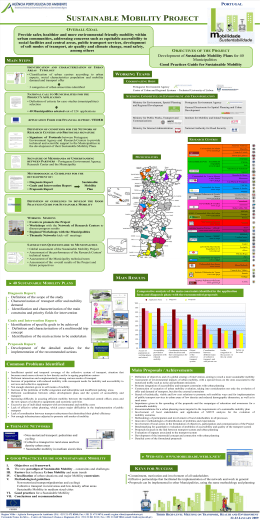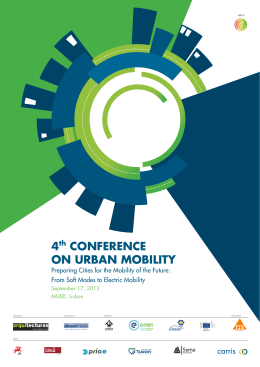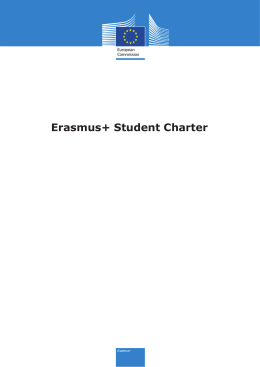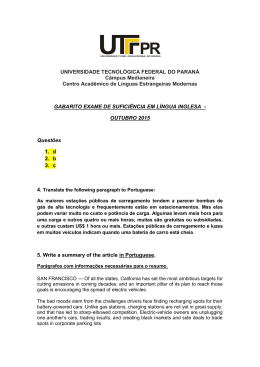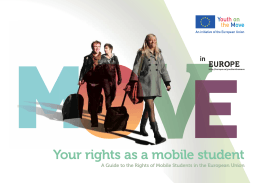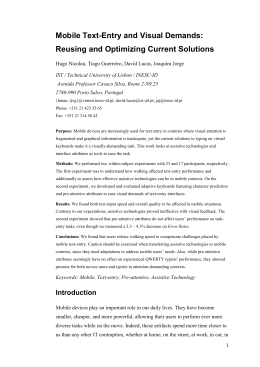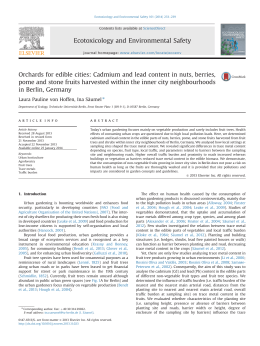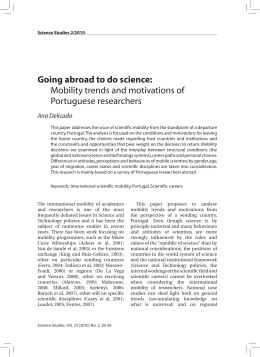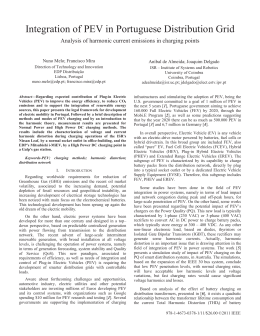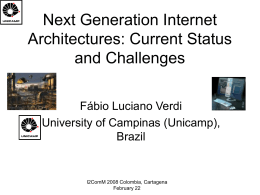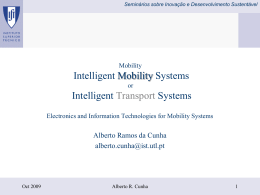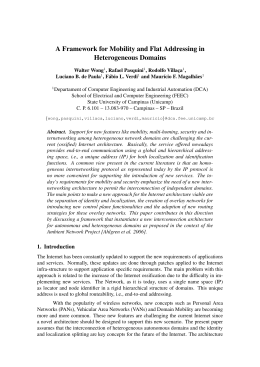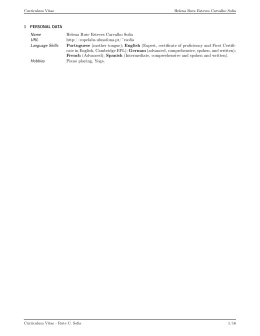ARTICLE IN PRESS Transport Policy 15 (2008) 73–80 www.elsevier.com/locate/tranpol The sustainable mobility paradigm David Banister Transport Studies Unit, Oxford University Centre for the Environment, Oxford, UK Available online 19 November 2007 Abstract This paper has two main parts. The first questions two of the underlying principles of conventional transport planning on travel as a derived demand and on travel cost minimisation. It suggests that the existing paradigm ought to be more flexible, particularly if the sustainable mobility agenda is to become a reality. The second part argues that policy measures are available to improve urban sustainability in transport terms but that the main challenges relate to the necessary conditions for change. These conditions are dependent upon high-quality implementation of innovative schemes, and the need to gain public confidence and acceptability to support these measures through active involvement and action. Seven key elements of sustainable mobility are outlined, so that public acceptability can be more effectively promoted. r 2007 Elsevier Ltd. All rights reserved. Keywords: Behaviour; Acceptability; Engagement; Participation 1. The problem It has often been said that transport planning is at a crisis point and that it underestimates the key challenges facing urban planners (Banister, 2005; Balaker and Staley, 2006; Wickham, 2006). Yet it has also been remarkably robust and it has ‘‘survived’’ all these crises to emerge almost intact, perhaps with some minor alterations. Two fundamental principles are embedded in the approach used, namely that travel is a derived demand and not an activity that people wish to undertake for its own sake. It is only the value of the activity at the destination that results in travel. The second principle is that people minimise their generalised costs of travel, mainly operationalised through a combination of the costs of travel and the time taken for travel. These two underlying principles have important consequences, as they are embedded in most analysis and evaluation studies. They help explain the predominance of transport solutions to urban problems, and the huge growth in faster and longer distance travel, as the increased speed of travel has outweighed the increased costs of travel. Even though travel time may have remained constant as cities have spread, both distances and speeds have increased E-mail address: [email protected] 0967-070X/$ - see front matter r 2007 Elsevier Ltd. All rights reserved. doi:10.1016/j.tranpol.2007.10.005 substantially (Banister, 2006; Deakin, 2006; Duranton, 2006; Kahn, 2006). Local public transport, cycle and walking have become less attractive, and this in turn has resulted in the greater use of the car. Car dependence and the increased decentralisation of cities are difficult processes to reverse—this is the transport-led future. Sustainable mobility provides an alternative paradigm within which to investigate the complexity of cities, and to strengthen the links between land use and transport. The city is the most sustainable urban form and it has to provide the location where most (70–80%) of the world’s population will live. Empirical research has concluded that the key parameters of the sustainable city are that it should be over 25,000 population (preferably over 50,000), with medium densities (over 40 persons per hectare), with mixed use developments, and with preference given to developments in public transport accessible corridors and near to highly public transport accessible interchanges (Banister, 2005, 2006). Such developments conform to the requirements of service and information-based economies. Settlements of this scale would also be linked together to form agglomerations of polycentric cities, with clear hierarchies that would allow a close proximity of everyday facilities and high levels of accessibility to higher order activities (Hall and Pain, 2006). ARTICLE IN PRESS 74 D. Banister / Transport Policy 15 (2008) 73–80 Such urban forms would keep average trip lengths below the thresholds required for maximum use of the walk and cycle modes. It would also permit high levels of innovative services and public transport priority, so that the need to use the car would be minimised. Through the combination of clear planning strategies, cities would be designed at the personal scale to allow both high-quality accessibility and a high-quality environment. The intention is not to prohibit the use of the car, as this would be both difficult to achieve and it would be seen as being against notions of freedom and choice. The intention is to design cities of such quality and at a suitable scale that people would not need to have a car. This alternative approach requires clear and innovative thinking about city futures in terms of the reality (what is already there) and the desirability (what we would like to see), and the role that transport can (and should) play in achieving these objectives. This paper describes these two fundamental problems with the traditional perspective on transport planning, and it then goes on to discuss what have been called schizophrenic paths, when it is clear that action is needed but no effective action is taken to remedy the situation (Banister, 2005, p. 234). 2. Two dilemmas 2.1. Transport as a derived demand or as a valued activity? With respect to the work journey, travel time is important, but as travel patterns change and there is an increase in leisure-based travel, travel time may become more of a positively valued activity (Loo and Chow, 2006; Schlich et al., 2004; Mokhtarian et al., 2006). The notion that all travel is a derived demand may become weaker as incomes rise and as leisure time becomes more valuable (Mokhtarian and Salomon, 2001). Escape theory (Heinze, 2000) hypothesises that leisure mobility is an attempt to compensate for a declining quality of life and travel opportunities are sought to get away from ones everyday environment to do something completely different. A substantial amount of leisure travel is undertaken for its own sake and the activity of travelling is valued. Conventional transport analysis is based on the premise that travel is a cost, and that travel times should be as short as possible. But this is changing as the new technology allows much greater travel time flexibility, including mobile working. It provides tremendous opportunity and choice in leisure activities, whether this means time spent online in the home, or taking the opportunity to book a last minute holiday overseas, or adapting existing activities (such as shopping). In each case, there seems to be a strong complementarity between the old (transport) and the new (ICT) technologies. Travel can be replaced by more ‘‘athome’’ activities, whilst in other cases more spontaneous travel is generated, and in a third group there is a modification of existing activities, as shopping for example becomes a multitasking activity through a combination of the Internet (e.g. viewing, deciding and buying) and travel (e.g. collection or delivery). The knowledge base is extended and this may again result in more travel, but more important is the transfer of power from the producer to the consumer. Increasingly, users will control their leisure and shopping activities tailored to their own specific requirements. Consumers will determine what type of leisure activity they participate in, where and when it takes place, who actually goes with them, and the range of alternatives will also increase substantially. For an accessible sustainable city to become a reality requires active citizen support and new forms of communication between experts and citizens, through new forums for discussion and the involvement of all major stakeholders (Section 4). 2.2. Time minimisation and reasonable travel time There is a contradiction between the desire to speed up and the desire to slow traffic down. For evaluation purposes, much of the user benefit (often over 80% of total benefits) is derived from the savings in travel time and the desire to travel faster. This is not the place to enter the debate on how these values of timesaving are derived, or how they are used by the beneficiaries, or in the analysis. But there does seem to be an inconsistency in the travel timesavings argument within cities, where much effort is now going into slowing traffic down for environmental and safety reasons. Although it is not explicitly stated, a certain level of congestion on roads is now seen as ‘‘desirable’’ and in many locations (e.g. residential streets and around schools), new low speed limits have been introduced, together with appropriate enforcement measures (e.g. speed cameras). So, on the one hand, there are the perpetual complaints from industry that the time lost in congestion is costing business money, and on the other hand, there is a transport strategy that both tries to speed traffic up and slow it down. The notion of a transport system with no congestion has never been a realistic objective, and much of the recent debate has been over what should be considered as a reasonable level of congestion (Urry and Lyons, 2005). The key policy objective now becomes that of reasonable travel time, rather than travel time minimisation. People and businesses are already concerned about knowing how much time it should take to travel to their destination with a reasonable degree of certainty. It is the reliability of the system that is crucial (Noland and Polak, 2002). 3. Contrasting approaches to transport planning These two points are both important in terms of understanding the rationale behind transport analysis, as many of the methods used cannot handle travel as a valued activity or travel time reliability. But they also have important implications for transport planning, if it is to embrace the concepts of a sustainable mobility. The ARTICLE IN PRESS D. Banister / Transport Policy 15 (2008) 73–80 primary concerns over the physical dimensions (urban form and traffic) should be balanced by the social dimensions (people and proximity), as illustrated in Table 1. The sustainable mobility approach requires actions to reduce the need to travel (less trips), to encourage modal shift, to reduce trip lengths and to encourage greater efficiency in the transport system. 3.1. Reducing the need to travel—substitution In its pure form this means that a trip is no longer made, as it has either been replaced by a non-travel activity or it has been substituted through technology, for example Internet shopping. The impact of ICT on transport is complex and most recent thinking (Banister and Stead, 2004) argues for complementarity between transport and ICT. Although there is a large substitution potential, the relationships between transport and ICT seem to be symbiotic with a greater opportunity for flexibility in travel patterns, as some activities are substituted, whilst others are generated, and some replaced by fewer longer distance journeys (Lyons and Kenyon, 2003). 3.2. Transport policy measures—modal shift Transport policy measures can reduce levels of car use through the promotion of walk and cycle and the development of the new transport hierarchy (Table 1). This can be achieved through slowing down urban traffic and reallocating space to public transport, through parking controls and road pricing, and through making it easier to use public transport. Demand management is effective in 75 restricting access and reallocating space, and making more effective use of the available capacity. A much wider notion of the street is being created, as it is no longer only being considered as a road but also as a space for people, green modes and public transport. Creative use of this space at different times of the day or day of the week means also that new uses can be encouraged (e.g. street markets or play zones). Measures to encourage modal shift must be combined with strategies to make the best use of the ‘‘released space’’, so that there is a net reduction in traffic (Banister and Marshall, 2000). 3.3. Land-use policy measures—distance reduction These measures address the physical separation of activities and the means by which distance can be reduced. The intention is to build sustainable mobility into the patterns of urban form and layouts, which in turn may lead to a switch to green modes of transport. It is one area of public policy where intervention can take place, through increasing densities and concentration, through mixed use development, through housing location, through the design of buildings, space and route layouts, through public transport oriented development and transport development areas, through car-free development, and through establishing size thresholds for the availability of services and facilities. The timescale over which sustainable mobility might be realised is similar to the turnover of the building stock (about 2% per annum), but decisions on the location of new housing will have a single dramatic effect on travel patterns and these effects will impact over the lifetime of this housing (Banister and Hickman, 2006). Table 1 Contrasting approaches to transport planning 3.4. Technological innovation—efficiency increase The conventional approach— transport planning and engineering The role of technology is important as it impacts on the efficiency of transport directly through ensuring that the best available technology is being used in terms of engine design, alternative fuels, and the use of renewable energy sources. Standards can also be introduced to reduce levels of noise and emissions at source, and measures can be taken to ensure that access to certain parts of the city is restricted to those vehicles that are seen to be environmentally cleaner than other vehicles. This is a combination of technological efficiency and behavioural change (e.g. ecological driving and adherence to speed limits). It would also include increasing load factors in both the passenger and freight sectors. Summarising these four actions, it seems that the key to such a shift in thinking is the creation of spaces and localities in the city that are attractive and affordable, as neighbourhood quality is central to sustainable mobility. Transport planning must involve the people,1 so that there is an understanding of the rationale behind the policy An alternative approach—sustainable mobility Physical dimensions Social dimensions Mobility Accessibility Traffic focus, particularly on the People focus, either in (or on) a vehicle car or on foot Large in scale Local in scale Street as a road Street as a space Motorised transport All modes of transport often in a hierarchy with pedestrian and cyclist at the top and car users at the bottom Forecasting traffic Visioning on cities Modelling approaches Scenario development and modelling Economic evaluation Multicriteria analysis to take account of environmental and social concerns Travel as a derived demand Travel as a valued activity as well as a derived demand Demand based Management based Speeding up traffic Slowing movement down Travel time minimisation Reasonable travel times and travel time reliability Segregation of people and traffic Integration of people and traffic Source: Adapted from Marshall (2001) (Table 9.2). 1 People are used here to cover all stakeholders with an interest in the quality of their local environment. ARTICLE IN PRESS 76 D. Banister / Transport Policy 15 (2008) 73–80 changes and that behavioural change follows. Public acceptability is core to successful implementation of radical change, and it must involve community and stakeholder commitment to the process of discussion, decision-making and implementation. 4. Involving the people 4.1. The issues There has been much discussion over delivering sustainable mobility, and the measures available are well known. There is even agreement between the main actors concerned about what should be done. There is also a growing literature on the barriers to implementation and why outcomes never match up with expectations. The commonly used economic arguments of rationality and complete knowledge do not seem to apply in transport.2 Much of the debate has centred on awareness raising, information, education, the use of the media and advertising as the means to achieve sustainable mobility (OECD, 2002). But there always seems to be a reason for not changing and maintaining the status quo. However good public transport is, there will always be an additional reason for still using the car. The car manufacturers are adept at selling the symbolism and seductiveness of the car (Cass et al., 2005). Ownership of cars as with all other consumer goods will always become cheaper over time, so that more people can afford to own one. The main barriers to entry are not the cost of the vehicle, but the costs of insurance and the need to pass the driving test. Charges to use the car may increase substantially, but political pressures are always present to moderate any substantial rises in price, so that motoring remains relatively cheap. The key is looking at other ways to reduce car use, through the use of ‘‘push and pull’’ measures (OECD, 2004), but much of the literature relates to the difficulty if not the impossibility of effective implementation of sustainable mobility (Banister and Marshall, 2000; Banister, 2005). This section outlines the means by which public acceptability can be raised to levels that will encourage support and engagement in actions to promote sustainable mobility. 4.2. Public acceptability Public acceptability drives political acceptability, and it is only when there is sufficient public support for change, that action will take place. For example, congestion is now 2 Note that the Nobel prize for economics was awarded to Daniel Kahneman (November 2002). His research in the 1970s argued against rationality, suggesting that people worry more about losing what they have rather than about winning a bigger stake. Although his work focused on behavioural finance and the way in which markets sometimes have ‘‘bursts irrational exuberance’’, prospect theory still seems relevant to individuals’ transport decisions today, as it relates actions to uncertainty and risk. accepted as a major constraint on individuals’ quality of life and the efficiency of business. Increasingly, surveys of public opinions in the EU are indicating that change is essential and that action is expected. Both the general public and business support priority being given to environmentally friendly modes, and even decision makers agree (usual levels of support are about 80%). Yet the same people are less positive in their views of the support of others (e.g. the public’s perceptions of the politicians’ views) for the same policies (typically around 40%). This suggests that there may be a greater than expected willingness to experiment with policies to reduce trip lengths, to combine trips, to switch modes, or to cancel trips altogether and to reduce the need to use the car (Section 3). In addition, it seems necessary to understand the implications and expectations of the individual. There are two key elements to the personal (rather than the social) dimension. The first is that there is an acceptance that the policy package being proposed will work and is efficient. The second is that it is fair, both to the individual travellers, and more generally to society as a whole. A small initial change, if sufficiently well supported and publicised (e.g. European Mobility Week involved 964 cities—19–23 September 2006), can lead to new attitudes to the car. It is through the active involvement of users of transport in a partnership that change can be realised. There are many such events happening in cities through direct action (e.g. Reclaim the Streets), through the reallocation of spaces and streets to people (e.g. the World Squares initiative, pedestrianisation, street closures), through lowering speed limits (e.g. Home Zones), through travel plans, and through cycle networks and exclusive bus networks. It must be seen as an active process that is participatory and inclusive. 4.3. Healthy transport Transport-induced emissions are linked to declining public health, and there is now evidence of the strong links between lack of exercise and obesity (Pucher and Dijkstra, 2003). Walking, cycling and public transport are all more healthy than using the car and are promoted as active transport. However, there are still the indirect effects of pollution, which damages health and causes problems related to asthma, bronchitis, leukaemia and lung disease. There are also the wider effects of increases in CO2 and the other greenhouse gases. Sustainable mobility offers improvements in individual health as well as a cleaner and healthier environment (Woodcock et al., 2007). Healthy transport means strong action on separating people from traffic and having exclusive routes for people and cyclists. It also means the promotion of travel plans for all businesses and activities that are major generators of traffic. For example, every school in the UK will have their own School Travel Plan by 2010. It is often thought that such policies are politically unpopular, but there now seems ARTICLE IN PRESS D. Banister / Transport Policy 15 (2008) 73–80 to be strong support for action and many decision makers have underestimated the strength of feeling for change. 4.4. Demonstration effects To many people, sustainable mobility requires a radical change in the way in which travel decisions are made. Naturally, people feel nervous about it, and they are reluctant to alter their behaviour,2 so there should be positive demonstration effects. In the EU, there is an acceptance that transport users ought to pay their full external costs, and several pricing initiatives have been introduced under the umbrella of fair and efficient pricing (CEC, 1995, 2006). Some countries in the EU now relate the annual taxation for vehicles to their pollution profile. Germany has established different classes of cars for annual taxes levied on owners of cars. Electric cars are completely tax-free for the first 5 years. There are dramatically reduced tax rates for the more energy-efficient and least polluting cars, and much higher rates for large cars that are energy inefficient and more polluting. Cars meeting Euro IV standards are considered especially sustainable and benefit from a large tax reduction (German Federal Ministry for Finance, 2003). In the UK, annual vehicle taxation is related to the CO2 emissions figures, with six bands. This provides some incentive for car owners to buy more efficient and cleaner vehicles. Car-sharing promotes new forms of ownership and there are more than 70,000 members Europe, in particular in Germany and Switzerland (APTA, 2004). Probably the best example of demonstration effects is the experience from congestion charging in Central London. This is the most radical transport policy that has been introduced in the UK in the last 20 years. It represents a watershed in policy action. The idea had been around for many years, but no politician had the conviction of actually taking it forwards. Even with a new mayor hugely committed to congestion charging, it was a struggle to get it through the legal, planning and political processes within a 30-month period (1 July 2000 to 17 February 2003). This relates strongly to the issue of the conflicts between long and short-term strategies (Banister, 2003). The long-term view is that congestion charging is an essential element of a sustainable transport strategy, whilst the short-term view is that it is almost impossible to introduce in a 4-year electoral cycle that exists in the UK. To achieve public acceptability, there has been extensive consultation with all parties, resulting in some compromise. For example, under half (45%) of vehicles coming into the Central London congestion charging zone actually pay the full charge (£5—raised to £8 in July 2005), while a further 29% have discounts of varying kinds, and the remaining 26% of vehicles are exempt. The large number of discounts and exemptions has reduced the effectiveness of the policy, and problems may be created later if these exemptions are to be reassessed. There was also a reduction 77 Table 2 Impacts of congestion charging in Central London 1. Traffic down 20% entering the congestion charging zone and some 16% within the zone 2. Speeds increased 15% within the zone and delayed 30% 3. Increase of 5% in traffic on Inner Ring Road around the zone, but little change in traffic speeds 4. About 100,000 motorists pay each day 5. Most travellers have switched to bus services—which run more freely and services have been increased, with +16% bus patronage, reliability improved (30% reduction in wait time) and speeds have increased by over 15% in the central area 6. Environmental improvements with 19% in CO2 emissions 7. Net revenues from the congestion charging scheme are about £120 million per annum (2006) 8. Public acceptance is now 55% for the scheme and 30% against it, when before implementation the figures were 40% for and 40% against Source: Transport for London (2006). in the proposed charge of £15 for lorries to £5, minor boundary changes, and a slight shortening of the charging period (07.00–18.30 on weekdays and shortened again to 18.00 in February 2007 when the scheme was doubled in size). Much analysis and monitoring is being carried out to determine both the transport and the non-transport impacts of congestion charging (TfL, 2006; Table 2). Such an example raises important policy dilemmas. The potential demonstration effects of the congestion charging scheme are substantial, as many other cities may learn from London and introduce their own schemes (e.g. Stockholm). But in order to achieve implementation, many concessions have been made, and these may in turn reduce the effectiveness of congestion charging. A balance must be struck between the desired scheme and an acceptable scheme. The potential risk is substantial, but such choices have to be made if radical sustainable mobility polices are to be introduced at all. Conversely, implementation of a scheme could be seen as the first step in a process where incremental changes are then added to the basic scheme until the final goal of a full electronic road-pricing scheme in London is achieved. In the first 3 years (February 2003 to 2006), the scheme and the technology have worked well and gained widespread acceptance, with measurable reductions in both traffic levels (15–20%) and congestion (over 20%) in Central London and around the congestion charging area. In this case, both the social norms and perceptions of its effectiveness were sufficiently high for implementation, and the outcome has exceeded expectations (Table 2). 4.5. Individual marketing Much of conventional choice theory assumes that each individual has complete knowledge of the alternatives and can make a rational choice. More recent empirical research (Brög et al., 2004) suggests that a much more proactive approach is required that not only informs individuals ARTICLE IN PRESS 78 D. Banister / Transport Policy 15 (2008) 73–80 about the alternatives that are available but also helps them decide which is most suitable for them. Information has to be taken to the customer, rather than assuming that they will find it themselves. Individualised marketing is a good example of this dialogue-based technique for promoting the use of public transport, cycling and walking as alternatives to the car. It has been developed and applied in several European and Australian cities with positive outcomes (reductions in car use of around 10%), and more importantly, it seems that changes in travel behaviour are maintained over time (see Curtis, this volume). Public acceptability of sustainable mobility seems to be high provided that social norms can be changed and the policy measures are presented as a package that can effectively be implemented. The process needs to build up trust and respect between the different actors over time, so communication and active involvement are essential. It also seems that legitimacy must be based on a participatory and inclusive approach that involves ‘‘selling’’ the message of sustainable mobility to individuals, groups and localities through explaining the need for changes in behaviour and convincing them of the importance of their contribution. This responds to the Schade and Schlag (2003) goals of importance and fairness in urban transport pricing strategies, and the need to both guide and force change (Vlek, 2000). In many situations, there are strong positive measures (reducing global warming and healthy transport) that can be promoted, but underlying success is the need for a high-level commitment to sustainable mobility and strong leadership. 5. Principles of the sustainable mobility paradigm The four basic types of actions to achieve sustainable mobility have been outlined in Section 3 and some innovative means by which the people can be involved have been identified in Section 4. The principles of a sustainable mobility paradigm need to combine these elements into a series of consistent policy measures. Four key elements are suggested here: (a) Making the best use of technology, including investment in technology in transport modes, information systems and in the transport system itself, and in giving industry directions on priorities (e.g. on hybrid and fuel efficient vehicles and alternative fuels). For the general public, these options are not controversial, as they enable them to carry out their activities with minimal change. But, there would also need to be behavioural change, with ecological driving and driving within speed limits, as well as looking at ways to increase occupancy levels. This would help achieve the efficiency objective, but there may be rebound effects, as people may drive more because the vehicles are more efficient. (b) Regulation and pricing means that the external costs of transport should be reflected in the actual costs of travel through higher fuel prices or through some form Table 3 Key elements in promoting the public acceptability of sustainable mobility Information Education, awareness campaigns, and promotion through media and social pressure are an essential starting point Explanation of the need for sustainable mobility, emphasising the positive economic, social and health benefits to the individual and businesses Involvement and The process must be inclusive, with clear communication aims and an understanding of the consequences to those on whom the strategy will impact Designed to gain support and understanding, so that stakeholders can buy into the proposals Raise levels of consistency between expectations and outcomes Packaging Push and pull policies measures need to be combined in mutually supporting packages. Policies restricting car use or raising its costs should be accompanied by well-publicised programmes to improve the availability and attractiveness of alternatives to driving alone, including car pooling, public transport, cycling and walking, all financed by dedicated revenues from car pricing measures Selling the benefits It is necessary to widely publicize the benefits, even if there are costs, inconvenience and sacrifice. Car drivers support funding of alternative modes to reduce congestion on the roads they drive on. Overweight or obese individuals would directly benefit from better walking and cycling conditions. Everyone benefits from cleaner air and safer traffic conditions. More walking, cycling and public transport use would help relieve parking shortages. These are important and direct impacts that all individuals can support Adopt controversial policies in Support needs to be built up in terms of stages positive outcomes and measurable improvements in the quality of life Politics is about reflecting prevailing preferences and also forming opinions Acceptance of responsibilities and commitment to change through actions is the key to success Consistency between different Some measures (e.g. pricing) that are measures and policy sectors common to all futures. Such measures need to be implemented now, even though their impacts may not be immediate Regulations, standards, subsidies and tax incentives should all be used to encourage manufacturers and other transport suppliers to develop and adopt the most energy efficient and environmentally friendly technology possible The precautionary principle should be followed, particularly on the global warming effects of transport emissions, ARTICLE IN PRESS D. Banister / Transport Policy 15 (2008) 73–80 Table 3 (continued ) Adaptability and actions should be consistent over the longer term Many of the problems created for the transport system do not emanate from the transport sector, but from other sectors. So a more holistic perspective is needed that integrates decision-making across sectors and widens the public discourse Decisions today should not unnecessarily restrict the scope for future decisions, so that the adaptive behaviour of individuals and agencies can be assessed There is no prescription or blueprint for the correct procedures to follow. Each situation requires separate analysis and implementation, including flexibility to change policy measures if intentions and outcomes do not match up. Assessment of risk and reversibility are both strong components of sustainable mobility Adaptability is not an excuse for inaction or weak action. It is an argument for clear decision making, leadership, supported by analysis and monitoring to check on the effectiveness of policy action of road user charging. Demand management reduces congestion and improves environmental quality, but it does require public support to work effectively. This would help reduce the numbers of trips, trip distance, change modal shares and promote more efficient vehicles. (c) Land-use development, including planning and regulations, needs to be integrated, so that physical restraint measures and development patterns are used to support shorter travel distances. Improved levels of proximity would help reduce distance travelled, and contribute to trip reduction and modal split changes. (d) Clearly targeted personal information, including social pressure, awareness raising, demonstration, persuasion and individual marketing, is also crucial. Acceptability is an essential (yet often neglected) element of sustainable mobility. The sustainable mobility paradigm is moving towards an objective-based planning system that is trying to implement a range of policy interventions, but with an important additional element, namely the support of all stakeholders. Underlying this discussion is the need to understand behaviour, and to explore the means by which cooperation and support can be obtained, so that real change can take place. The notion of personal utility must be placed in the wider context of social welfare. Table 3 summarises the key elements in promoting public acceptability. The first four elements are widely used, as many cities are already actively involved in 79 implementing policies on sustainable mobility, through providing information, through ensuring effective involvement and communication, through packaging of policy measures and through selling the benefits. Given the direct benefits it would provide, this is a message that should provide an effective source of public and political support. But the scale of change required to promote a more effective strategy on sustainable mobility means that a deeper understanding of acceptability is needed. Rather than trying to encourage automatic responses and continuous evaluation in terms of the benefits to individuals, the debate must also embrace reasoned actions that examine the whole process in terms of societal benefits, where all options and implications are considered. Behavioural change must be seen as part of the solution and the last three elements are more controversial (Table 3). Here the intention is to be realistic yet consistent in implementing policy packages on sustainable mobility, through a phased approach that moves flexibly in the direction of longer term goals. 6. Conclusions The messages are clear. There is strong support for enlarging the scope of public discourse and empowering the stakeholders through an interactive and participatory process to commit themselves to the sustainable mobility paradigm. The open and active involvement of all parties would be far more effective than the conventional passive means of persuasion. Thus, broad coalitions should be formed to include specialists, researchers, academics, practitioners, policy makers and activists in the related areas of transport, land use, urban affairs, environment, public health, ecology, engineering, green modes and public transport. It is only when such coalitions form that a real debate about sustainable mobility can take place. There must be a willingness to change and an acceptance of collective responsibility. To achieve sustainable mobility, the arguments must be sufficiently powerful to overcome the dependence on the car and the possibility that the costs of delay and congestion have already been internalised by drivers. The measures needed to achieve sustainable mobility in cities are already well known and many have been implemented in different situations with varying degrees of success. The sustainable mobility paradigm goes beyond the actual measures and attempts to understand the reasons behind effective implementation. The concepts of travel as a derived demand and time minimisation have been questioned, and a case made for more flexible interpretations of why people travel and how they use time. Effective implementation of sustainable mobility requires the engagement of key stakeholders, so that they can understand the reasoning behind different policy initiatives and support their introduction. Some of the processes to achieve such a change are outlined and the key elements in promoting the sustainable mobility paradigm ARTICLE IN PRESS 80 D. Banister / Transport Policy 15 (2008) 73–80 have been summarised. Sustainable mobility has a central role to play in the future of sustainable cities, but it is only through the understanding and acceptance by the people that it will succeed. References American Public Transportation Association (APTA), 2004. More car sharing in Europe. /http://www.apta.com/services/intnatl/intfocus/ 020722carsharing.cfmS. Balaker, T., Staley, S., 2006. The Road More Travelled. Rowman & Littlefield, New York. Banister, D., 2003. Critical pragmatism and congestion charging in London. International Social Science Journal 176, 249–264. Banister, D., 2005. Unsustainable Transport: City Transport in the New Century. Routledge, London. Banister, D., 2006. Transport, urban form and economic growth. Paper presented at the ECMT Regional Round Table 137, Berkeley. Banister, D., Hickman, R., 2006. How to design a more sustainable and fairer built environment: transport and communications. IEEE Proceedings of the Intelligent Transport System 153 (4), 276–291. Banister, D., Marshall, S., 2000. Encouraging Transport Alternatives: Good Practice in Reducing Travel. The Stationery Office, London. Banister, D., Stead, D., 2004. Impact of information and communications technology on transport. Transport Reviews 24 (5), 611–632. Brög, W., Erl, E., Mense, N., 2004. Individualised marketing: changing travel behaviour for a better environment. In: OECD Communicating Environmentally Sustainable Transport: The Role of Soft Measures. OECD, Paris, pp. 83–97. Cass, N., Shove, E., Urry, J., 2005. Social exclusion, mobility and access. The Sociological Review 53 (3), 539–555. CEC (Commission of the European Communities), 1995. Towards fair and efficient pricing in transport. Green Paper COM(95)691, Brussels. /http://europa.eu.int/en/record/green/gp9512/ind_tran.htmS. Commission of the European Communities, 2006. Keeping Europe moving: sustainable mobility for our continent. Midterm Review of the European Commission’s 2001 Transport White Paper, COM(2006) 314 Final, 22 June 2006, Brussels. Deakin, E., 2006. Transportation, urban form and economic growth. Paper presented at the ECMT Regional Round Table 137, Berkeley. Duranton, G., 2006. The insatiable demand for land: urban change and land (re-) development. Paper presented at the ECMT Regional Round Table 137, Berkeley. German Federal Ministry for Finance, 2003. /http://www.bundesfinanzministerium.de/Anlage26975/Bilanz-der-Oekologischen-Steuerreform. pdfS. Hall, P., Pain, K., 2006. The Polycentric Metropolis: Learning from Mega-City Regions in Europe. Earthscan, London. Heinze, G.W., 2000. Transport and leisure. Paper prepared for presentation at the ECMT Round Table 111 on Transport and Leisure, Paris, pp. 1–51. Kahn, M., 2006. The quality of life in sprawled versus compact cities. Paper presented at the ECMT Regional Round Table 137, Berkeley. Loo, B., Chow, S., 2006. Sustainable urban transportation: concepts, policies, and methodologies. Journal of Urban Planning and Development 132 (2), 76–79. Lyons, G., Kenyon, S., 2003. Social participation, personal travel and Internet use. In: Proceedings of the 10th International Conference on Travel Behaviour Research, Lucerne. Marshall, S., 2001. The challenge of sustainable transport. In: Layard, A., Davoudi, S., Batty, S. (Eds.), Planning for a Sustainable Future. Spon, London, pp. 131–147. Mokhtarian, P., Salomon, I., 2001. How derived is the demand for travel? Some conceptual and measurement considerations. Transportation Research A 35, 695–719. Mokhtarian, P., Salomon, I., Handy, S., 2006. The impacts of ICT on leisure activities and travel: a conceptual exploration. Transportation 33 (3), 263–289. Noland, R., Polak, J., 2002. Travel time variability: a review of theoretical and empirical issues. Transport Reviews 22 (1), 39–54. OECD (Organisation for Economic Cooperation and Development), 2002. Global long term projections for motor vehicle emissions (MOVE II) project. Working Paper on National Environmental Policy. Working Group on Transport, ENV/EPOC/WPNEP/ T(2002)8/REV1, Paris. OECD (Organisation for Economic Cooperation and Development), 2004. Communicating environmentally sustainable transport: the role of soft measures. Report of the Workshop held in Berlin, December 2002. Pucher, J., Dijkstra, L., 2003. Promoting safe walking and cycling to improve public health: lessons from the Netherlands and Germany. American Journal of Public Health 93 (9), 1509–1516. Schade, J., Schlag, B., 2003. Acceptability of urban transport pricing strategies. Transportation Research F 6 (1), 45–61. Schlich, R., Schonfelder, S., Hanson, S., Axhausen, K., 2004. Structures in leisure time: temporal and spatial variability. Transport Reviews 24 (2), 219–238. Transport for London, 2006. Central London congestion charging— impacts monitoring. Fourth Annual Report for the Mayor of London, TfL. Urry, J., Lyons, G., 2005. Travel time use in the information age. Transportation Research Part A 39, 257–276. Vlek, C., 2000. Essential psychology for environmental policy making. International Journal of Psychology 35 (2), 153–167. Wickham, J., 2006. Gridlock: Dublin’s Transport Crisis and the Future of the City. New Island Books, Dublin. Woodcock, J., Banister, D., Roberts, I., Prentice, A., Edwards, P., 2007. Energy and transport. The Lancet 370, 1078–1088.
Download
